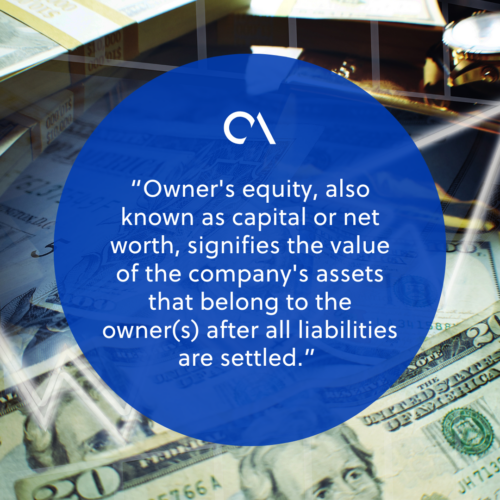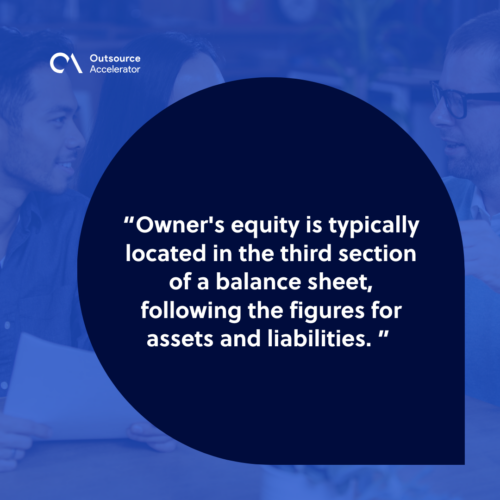What is owner’s equity?

One of the most important aspects to consider when operating a business is the company’s financial health.
All transactions and the organization’s assets and liabilities shall be accounted for and recorded correctly.
It is one reason business owners, not just their finance and accounting personnel, should be familiar with accounting terms, particularly those used to compose financial statements.
Owner’s equity is one of the key elements within the accounting equation and a critical metric for understanding a company’s present financial standing.
Whether you’re running a startup or a well-established business, learning the context of owner’s equity will determine how much the business remains to the owner after all the debts are recorded and paid.
Learn more about “What is owner’s equity?” in this article and underscore the significant effect of having its accurate calculation on a business operation.
What is owner’s equity?
Owner’s equity, also known as capital or net worth, signifies the value of the company’s assets that belong to the owner(s) after all liabilities are settled.
The term “owner’s equity” is applied to partnerships and sole proprietorships, whereas corporations utilize “shareholders’ equity” or “stockholders’ equity.”
Higher owner investment and profitable business operations contribute to an increase in owner’s equity. On the other hand, owner withdrawals and business losses cause it to decrease.
It highlights the importance of skilled accounting staff to accurately record and calculate owner’s equity. Small owners have now outsourced accounting staff for cost-efficient operations.

Why should you understand owner’s equity?
Aside from reflecting the total net value of the business and being a reliable indicator of financial health, understanding owners’ equity gives the organization more advantages.
Here are some of the reasons that can encourage you to check and know more about owners’ equity:
#1. Basis for business value and financing opportunities
Owner’s equity significantly determines a company’s true worth. Investors and buyers assess and analyze the status of the owner’s equity to gauge the business’s earning potential.
Lenders and investors also consider the value of the owner’s equity when financing a company’s continuation or expansion.
A company with a higher owner’s equity enhances the company’s creditworthiness. This secures loan offers and attracts more investments.
#2. Provides a more strategic and informed decision
Learning the figures, components, and changes in owner’s equity helps the organization to derive more informed decisions in areas of expansion, reinvestment, and a window for restructuring.
It provides insights into how profits are allocated and how withdrawals and owners’ contributions change a company’s financial status curves.
#3. Accurateness of financial reporting
As a fundamental element of financial statements, specifically the balance sheet, owner’s equity contributes to accurate tracking of the business’s economic status.
It is crucial for transparency and adherence to the business’s compliance and tax obligations. In-house or outsourced tax specialists use this as one of the bases for tax computations.
What comprises an owner’s equity?
The specific elements that constitute owner’s equity differ based on the legal structure of the business.
The specific elements that constitute owner’s equity are not entirely the same for sole proprietorships and partnerships compared to corporations.
For partnerships and sole proprietorship
- Capital contributions: Represent the initial and any later contributions of assets or cash made by the owner(s) to the business.
- Net income or net loss: This refers to both losses and earned profits from the business’s inception. Recorded losses decrease owner equity, while profits increase it.
- Owner’s withdrawals or drawings: These are the recorded amount or value of an asset taken out by the owner(s) for personal purposes, which reduces the owner’s equity.
For Corporations (Shareholders’ Equity):
- Common Stock: This denotes the overall value of shares distributed to investors, signifying their proportional stake in the company’s ownership.
- Preferred Stock: This is another kind of stock with specific privileges and rights compared to common stocks.
- Additional Paid-in Capital (APIC): Refers to the total value or amount an investor pays for a particular stock above its market value.
- Retained Earnings: This refers to the part of a corporation’s total accumulated earnings that has not been paid out to shareholders as dividends but kept within the company.
- Treasury Stock: Pertains to a share of a company’s stock bought back or repurchased from the market, which reduces the shareholder’s equity.
- Accumulated Other Comprehensive Income (AOCI): This includes particular losses or gains not initially reflected in the net income, such as losses or gains resulting from a specific investment.
How to calculate owner’s equity
This relationship is anchored in the basic accounting equation, which is rearranged to compose the equation that will be used to calculate owner’s equity.
| Assets = Liabilities + Owner’s Equity | Owner’s Equity = Assets – Liabilities |
As highlighted earlier, given the interpretations we can get from the equation, it is a good indicator of stability and financial health.
With the following factors from the example, we can now readily calculate owner’s equity using the given formula:
If the business has a total asset amounting to $3,500,000.00 but has recorded a total liability of $1,200,000.00, owner’s equity will be calculated with a total amount of $2,300,000.00.
$2,300,000.00 (Owner’s equity) = $3,500,000.00 (Asset) – $1,200,000.00 (Liability)
How to present owner’s equity using a balance sheet
Owner’s equity is typically located in the third section of a balance sheet, following the figures for assets and liabilities.
Its components consist of retained earnings, capital invested by the owner(s), and their withdrawals.

In addition, it is part of the fundamental accounting equation that ensures the balance sheet’s numbers and computations are correct.
Providing an accurate computation will give the company in-depth insights into its financial status, which is very relevant in making data-backed decisions.
Leveraging owner’s equity for more effective financial decisions
Comprehensively analyzing the total value of owner’s equity affects how business owners forecast potential risks and venture opportunities to sustain operations.
Knowing the correlation of each component is vital to understanding changes in total values and financial ratios.
It also helps the organization derive better strategies to expand operations and explore other ways to gain profit.
Owner’s equity also guides the profit distribution, borrowing, and investments a firm may consider achieving long-term growth, eventually translated to greater financial success.







 Independent
Independent




